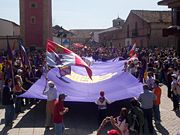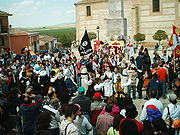
Castile and León Day
Encyclopedia

Castile and León
Castile and León is an autonomous community in north-western Spain. It was so constituted in 1983 and it comprises the historical regions of León and Old Castile...
, a subdivision of Spain
Spain
Spain , officially the Kingdom of Spain languages]] under the European Charter for Regional or Minority Languages. In each of these, Spain's official name is as follows:;;;;;;), is a country and member state of the European Union located in southwestern Europe on the Iberian Peninsula...
. The date is the anniversary of the Battle of Villalar
Battle of Villalar
The Battle of Villalar was a battle in the Revolt of the Comuneros fought on April 23, 1521 near the town of Villalar in Valladolid province, Spain. The royalist supporters of King Charles I won a crushing victory over the comuneros rebels. Three of the most important rebel leaders were...
, in which Castilian rebels were dealt a crushing defeat by the forces of King Charles I
Charles V, Holy Roman Emperor
Charles V was ruler of the Holy Roman Empire from 1519 and, as Charles I, of the Spanish Empire from 1516 until his voluntary retirement and abdication in favor of his younger brother Ferdinand I and his son Philip II in 1556.As...
in the Revolt of the Comuneros on April 23, 1521.
Commemoration of the Battle of Villalar was closely associated with liberal politics in Spain from the late 18th century until the 1970s, as conservatives generally sympathized with the royal government. With the demise of General Franco's government
Spanish transition to democracy
The Spanish transition to democracy was the era when Spain moved from the dictatorship of Francisco Franco to a liberal democratic state. The transition is usually said to have begun with Franco’s death on 20 November 1975, while its completion has been variously said to be marked by the Spanish...
, the day has broadened to a more general celebration of Castilian nationalism
Castilian nationalism
Castilian nationalism, or Castilianism, is a political movement that advocates for the national recognition of Castile, and in some cases, its independence....
rather than only liberal politics. The government of Castile and León
Castile and León
Castile and León is an autonomous community in north-western Spain. It was so constituted in 1983 and it comprises the historical regions of León and Old Castile...
established August 23 as an official holiday in 1986, and festivals have since been held yearly at Villalar
Villalar de los Comuneros
Villalar de los Comuneros is a municipality located in the province of Valladolid, Castile and León, Spain. According to the 2004 census , the municipality has a population of 449 inhabitants....
.
April 23 is the same day as St. George's Day, with there being some crossover between the two holidays.
Origins
The birth of the Battle of VillalarBattle of Villalar
The Battle of Villalar was a battle in the Revolt of the Comuneros fought on April 23, 1521 near the town of Villalar in Valladolid province, Spain. The royalist supporters of King Charles I won a crushing victory over the comuneros rebels. Three of the most important rebel leaders were...
as a rallying symbol for Spanish liberals dates back to the late 17th and early 18th centuries. León del Arroyal, an illustrious economist and protoliberal, stated that Villalar was "the last breath of Castilian freedom" in the latter half of the 18th century. The Castilian comuneros received their first major recognition during the Trienio Liberal, the three years of liberal government from 1820-1823. Resistance fighter Juan Martín Díez
Juan Martín Díez
Juan Martín Díez, nicknamed El Empecinado , was a historic Spaniard famous for his contributions to the Peninsular War.-Early life:Díez was born in Castrillo de Duero on September 5, 1775. He was a farmer and his house still exists in its original location...
organized an expedition to Villalar to search for the remains of Padilla, Bravo, and Maldonado, the executed leaders of the revolt. These events took its climax with a festival and celebration of the comuneros in the plaza of the Villalar on April 23, 1821. Members of left-leaning secret societies often referenced the revolt in their names, such as "Los comuneros" or "Sons of Padilla." They also employed the purple banner, the flag flown by the comuneros rebels. While dormant for a time after the Bourbon Restoration to the Spanish throne, occasional recognition of Villalar and the comuneros came from some of the short-lived liberal governments of the period. For instance, President Francisco Pi y Margall
Francisco Pi y Margall
Francisco Pi y Margall was a liberal Spanish statesman and romanticist writer. He was briefly president of the short-lived First Spanish Republic in 1873.-Early life:...
of the First Spanish Republic
First Spanish Republic
The First Spanish Republic was the political regime that existed in Spain between the parliamentary proclamation on 11 February 1873 and 29 December 1874 when General Arsenio Martínez-Campos's pronunciamento marked the beginning of the Bourbon Restoration in Spain...
stated that "Castile was among the first nations of Spain who lost their freedoms in Villalar under the first king of the House of Austria."
In the early years of the 20th century there were other attempts to celebrate at Villalar. Among them was a proposal by José María Zorita Díez, a liberal deputy for Valladolid, who made a special request for funds to commemorate the battle of Villalar. There were also various requests and preparations to celebrate the fourth centenary of the Battle in 1923; the city council of Palencia
Palencia
Palencia is a city south of Tierra de Campos, in north-northwest Spain, the capital of the province of Palencia in the autonomous community of Castile-Leon...
proposed in early 1923 that "on next April 23, all the representatives of Castile go to the fields of Villalar and swear upon the Castilian Holy Grail, at the scene of the Fall ... On the same day and at the same time all the cities of Castile dedicate a minute of silence to the heroes of Villalar." Little came of these attempts to celebrate April 23, however.
Official recognition

José Antonio Maravall
José Antonio Maravall Casesnoves was a Spanish historian and essayist.-Biography:Maravall studied philosophy and law at the University of Murcia, where he completed his final degree in political science and economics at the Central University, where he was a student of Jose Ortega y Gasset. He...
, Juan Ignacio Gutiérrez Nieto, and Joseph Pérez
Joseph Perez
Joseph Perez is a French historian specializing in Spanish history. Perez has specialized in the births of the modern Spanish state and the Latin American nations...
. In 1976, a gathering of about 400 people met at Villalar. While they were dispersed by the Guardia Civil, the meeting the next year was far larger, with almost 20,000 attendees to celebrate the Battle and organize pro-Castilian groups. The meetings continued on an unofficial basis until 1986, when the government of the recently recognized autonomous community of Castile and León
Castile and León
Castile and León is an autonomous community in north-western Spain. It was so constituted in 1983 and it comprises the historical regions of León and Old Castile...
granted its official stamp of approval.
Modern observance

The entity responsible for organizing the celebration in modern times is the "Villalar Foundation of Castile and León."

